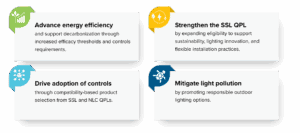Lighting for the future.
Thanks to the participation of our consortium, the DLC’s LED lighting program is home to the largest and most influential list of high-performing LED luminaires and commercial lighting products in the world. We work in tandem with energy efficiency programs to improve both the energy savings potential and quality of light in the built environment. The SSL (LED) Qualified Products List improves both consumer confidence and sustainability of the LED lighting market as a whole through well-researched criteria for efficiency and quality created by our expert team and with input from our stakeholders. Our rigorous vetting and review process to qualify for listing creates trust.


70%
increase in average efficacy of qualified LED products since beginning the program in 2011
SSL (LED) Technical Requirements
SSL Technical Requirements V5.1 is the currently active DLC Technical Requirements for commercial and industrial LED lighting products.
For more guidance on submitting products under SSL V5.1, see the V5.0 & V5.1 Manufacturer and Industry Guidance. V5.1 contains new quality of light requirements, including spectral quality and glare, and new controllability requirements.
The DLC Technical Requirements for LED Lighting: SSL Version 6.0 and LUNA V2.0, published on November 3, 2025, introduces a combined set of technical requirements and policies, streamlining what were previously multiple separate policy documents and marks an important milestone in advancing high-performing, energy efficient, and quality lighting for both indoor and outdoor non-residential applications.
| Version | Status | Effective Date | Update By | Delist Date | Documentation |
|---|---|---|---|---|---|
| Final Nov 3, 2025 | January 5, 2026 | October 9, 2026 | --- | View Technical Requirements | |
| ACTIVE | Jul 1, 2020 | Oct 9, 2026 | Dec 15, 2026 | Download PDF | |
| DELISTED | Feb 18, 2020 | Jan 31, 2021 | Jun 30, 2022 | Download PDF | |
| DELISTED | Oct 18, 2018 | Nov 15, 2020 | Feb 28, 2021 | Download PDF |
Technical Requirements for LED Lighting: SSL V6.0 & LUNA V2.0
Solid-State Lighting (SSL) Technical Requirements Version 6.0 (V6.0) and LUNA Version 2.0 (V2.0) is designed to improve the efficacy, quality, and controllability of DesignLights Consortium (DLC) listed high-performance lighting products by establishing new and updated performance requirements and reporting criteria for non-residential lighting and introduces a combined set of technical requirements, streamlining what were previously two separate documents.
The DLC Technical Requirements for LED Lighting: SSL Version 6.0 and LUNA V2.0 introduces a combined set of technical requirements and policies, streamlining what were previously multiple separate policy documents and marks an important milestone in advancing high-performing, energy efficient, and quality lighting for both indoor and outdoor non-residential applications.
This version of the technical requirements reflect the dialogue and input gathered since the launch of SSL V5.1 in 2020. It includes several key updates:
- A major revision to the DLC Premium classification, expanding beyond efficacy and quality to further enable incentives for advanced controls and integrated lighting systems
- Clear criteria and improved documentation for manufacturers and specifiers
- Alignment with technology advances in efficacy, quality of light, and system flexibility.
The goals of SSL V6.0 & LUNA V2.0 focus on improvements to performance emphasizing efficacy, controllability, and high quality of light for indoor and outdoor applications, as aligned with the DLC mission.

Light Usage for Night Applications (LUNA) is the DLC’s dark sky program that promotes rigorous performance criteria for specific categories of outdoor lighting so that lighting decision makers can be confident that their selections save energy AND follow best practices for nighttime lighting. LUNA V2.0 simplifies controls reporting by using SSL V6.0’s controllability requirements instead of its own specific controls requirements. The DLC is proposing that NWL outdoor products must meet both SSL V6.0 and LUNA V2.0 requirements to be listed. This includes three new Turtle Lighting Primary Use Designations (PUDs).
View and Download SSL V6.0 and LUNA V2.0 here.
© 2025 DesignLights Consortium. The DesignLights Consortium is a project of Efficiency Forward, Inc., a non-profit 501(c)3 organization. Privacy Policy Terms of Use


